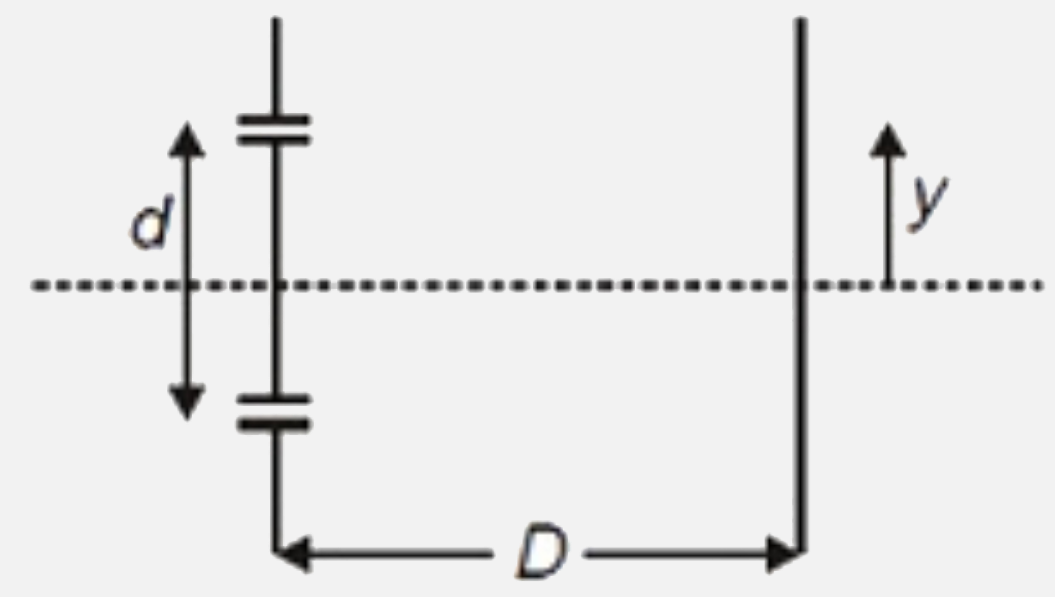Lights of wavelengths λ1=4500Å,λ2=6000Å are sent through a double slit arrangement simultaneously. Then
no interference pattern will be formed
the third order bright fringe of λ1 will coincide with the fourth order bright fringe of λ2
the third order bright fringe of λ2 will coincide with the fourth order bright fringe of λ1
the fringes of wavelength λ1 will be wider than the fringes of wavelength λ2
The correct Answer is:C
To solve the problem, we need to find the conditions under which the bright fringes of two different wavelengths coincide in a double slit arrangement.
1. Identify the Wavelengths:
We are given two wavelengths:
- λ1=4500Å
- λ2=6000Å
2. Understand the Condition for Bright Fringes:
The condition for bright fringes in a double slit experiment is given by the formula:
dsinθ=mλ
where d is the distance between the slits, θ is the angle of the fringe, m is the order of the fringe, and λ is the wavelength.
3. Set Up the Equation for Coinciding Bright Fringes:
For the p-th bright fringe of wavelength λ1 and the q-th bright fringe of wavelength λ2, we can write:
pλ1=qλ2
4. Express the Ratio of Orders:
Rearranging the equation gives us:
pq=λ2λ1
5. Substitute the Values:
Substitute the values of λ1 and λ2:
pq=6000Å4500Å=60004500=43
6. Cross Multiply to Find Orders:
From the ratio pq=43, we can express it as:
3p=4q
This means that for every 4th order bright fringe of λ2, there is a corresponding 3rd order bright fringe of λ1.
7. Conclusion:
Therefore, the 4th order bright fringe of λ1 coincides with the 3rd order bright fringe of λ2.
Final Answer:
The third order bright fringe of λ2 will coincide with the fourth order bright fringe of λ1.
We are given two wavelengths:
- λ1=4500Å
- λ2=6000Å
The condition for bright fringes in a double slit experiment is given by the formula:
dsinθ=mλ
where d is the distance between the slits, θ is the angle of the fringe, m is the order of the fringe, and λ is the wavelength.
For the p-th bright fringe of wavelength λ1 and the q-th bright fringe of wavelength λ2, we can write:
pλ1=qλ2
Rearranging the equation gives us:
pq=λ2λ1
Substitute the values of λ1 and λ2:
pq=6000Å4500Å=60004500=43
From the ratio pq=43, we can express it as:
3p=4q
This means that for every 4th order bright fringe of λ2, there is a corresponding 3rd order bright fringe of λ1.
Therefore, the 4th order bright fringe of λ1 coincides with the 3rd order bright fringe of λ2.
The third order bright fringe of λ2 will coincide with the fourth order bright fringe of λ1.
Topper's Solved these Questions
- WAVE OPTICSBOOK - DC PANDEY ENGLISHCHAPTER - WAVE OPTICSEXERCISE - Assertion reason
8 Videos
- WAVE OPTICSBOOK - DC PANDEY ENGLISHCHAPTER - WAVE OPTICSEXERCISE - match column
4 Videos
- WAVE OPTICSBOOK - DC PANDEY ENGLISHCHAPTER - WAVE OPTICSEXERCISE - Check point
65 Videos
- SOLVED PAPERS 2018BOOK - DC PANDEY ENGLISHCHAPTER - SOLVED PAPERS 2018EXERCISE - JIPMER
22 Videos
Similar Questions
Knowledge Check
Two sources of light of wavelengths 2500 Å and 3500 Å are used in Young’s double slit expt. simultaneously. Which orders of fringes of two wavelength patterns coincide?
A3rd order of 1st and 5th order of 2ndB7th order of 1st and 5th order of 2ndC5th order of 1st and 3rd order of 2ndD5th order of 1st and 7th order of 2ndTwo sources of light of wavelength 2500 Ã… and 3500 Ã… are used in Young's double slit experiment simultaneously. Which orders of fringes of two wavelength patterns coincide?
A3rd order of 1st source and 5th of the 2ndB7th order of 1st and 5th order of 2ndC5th order of 1st and 3rd order of 2ndD5th order of 1st and 7th order of 2ndIf K1andK2 are maximum kinetic energies of photoelectrons emitted when light of wavelength λ1andλ2 respectively are incident on a metallic surface. If λ1=3λ2 then
AK1>(K2/3)BK1<(K2/3)CK1=3K2DK2=3K1
In YDSE a parallel beam of incident light consists of two wavelengths λ1=4000Åandλ2=5600Å. The minimum distance y on the screen, measured from the central axis, where the bright fringe due to two wavelengths coincide is nλ1Dd. Find n.

View SolutionLight of wavelength λ=5890Å fall on a double-slit arrangement having separation d=0.2mm. A thin lens of focal length f=1m is placed near the slits. The linear separation of fringes on a screen placed in the focal plane of the lens is
View SolutionIn a Young's double slit experiment, a parallel beam containing wavelengths λ1=4000Å and λ2=5600Å is incident at an angle ϕ=30∘ on a diaphragm having narrow slits at separation d=2mm. The screen is placed at a distance D =40 cm from the slits. a mica slab of thickness t=5mm is placed in front of one of the slits and whole of the apparatus is submerged in water. if the central bright fringe is observed at C, determine.

(i) The refractive index of the slab
(ii) The distance of first black line from C
both wavelength are in air. take μw=43
View SolutionA double-slit interference pattern is formed on a screen in a Young's double slit experiment performed with light consisting of two wavelengths λ1 = 6000A and λ2 = 4800A. It is observed that the maximum of the 16th order corresponding to λ= 6000 A coincides with a maximum of the n order corresponding to λ= 4800 A The value of n is
View SolutionIf K1andK2 are maximum kinetic energies of photoelectrons emitted when light of wavelength λ1andλ2 respectively are incident on a metallic surface. If λ1=3λ2 then
View Solution
